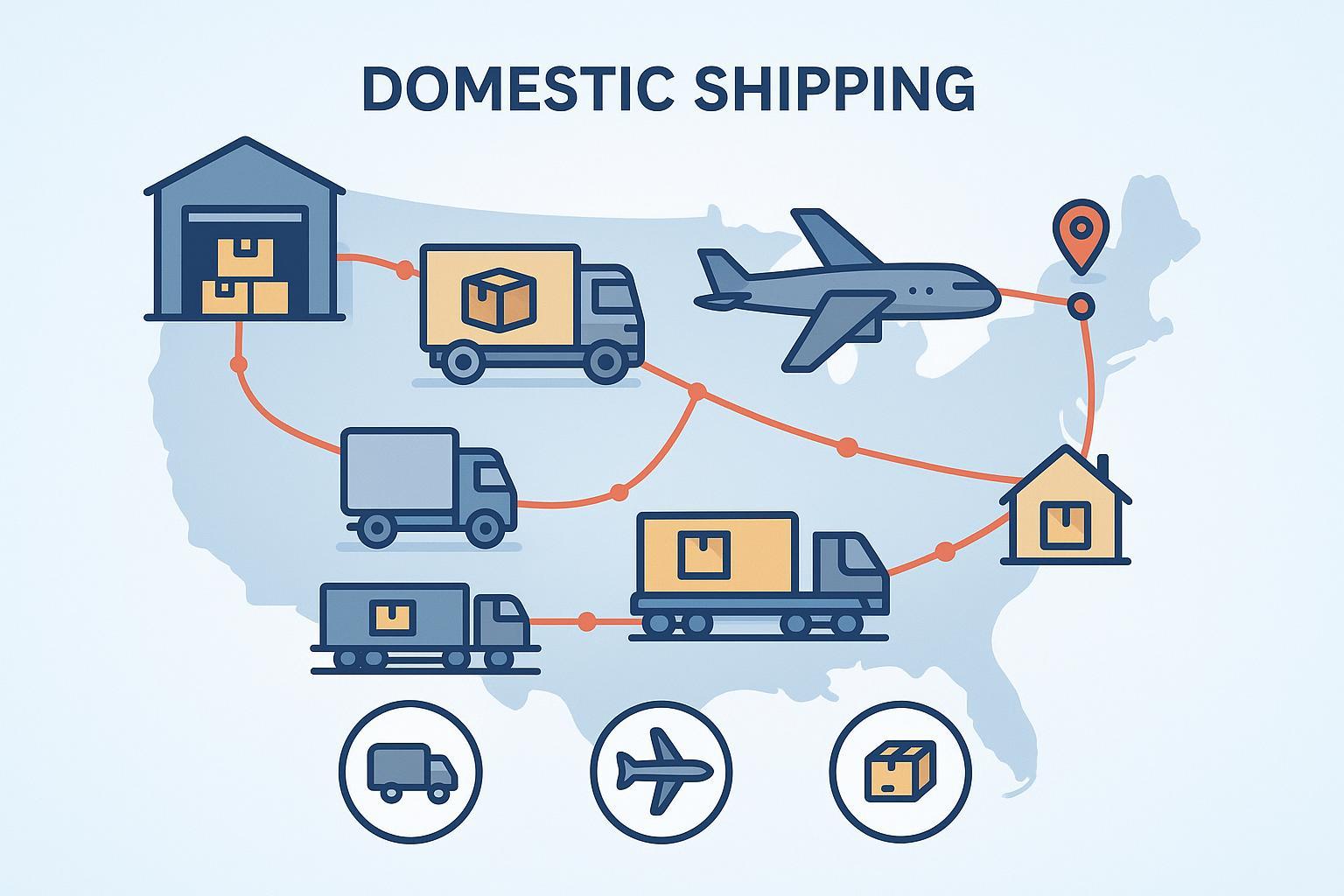
Domestic shipping is fundamental to the success of eCommerce and supply chain operations in any country. For business leaders, operators, and eCommerce professionals, grasping its intricacies provides a direct pathway to reducing costs, satisfying customers, and optimizing logistics strategy.
What Is Domestic Shipping?
Domestic shipping refers to the transportation of goods, parcels, or freight strictly within the boundaries of a single nation—including its contiguous territories—and subject entirely to local regulations, carrier networks, and logistical infrastructure (CSCMP). There’s no crossing of international borders, customs procedures, or foreign regulatory hurdles. Whether it’s a one-day delivery across a city or a multi-day haul from coast to coast, as long as both the origin and destination remain inside the country, the shipment is considered domestic.
Notably, domestic shipping encompasses all major modes—ground (trucks, courier vans), air (cargo flights), rail, and intermodal. Nuances arise with non-contiguous territories or remote regions, but all remain governed by home country laws and carrier practices (DHL).
How Domestic Shipping Works
The domestic shipping workflow consists of:
- Pickup: The carrier collects the goods from sender’s location.
- Sorting: Parcels are sorted at a regional or national hub/warehouse.
- Routing: Goods travel by truck, plane, or rail depending on size, urgency, and distance.
- Last-Mile Delivery: Items are brought to the final recipient—often with digital tracking and address validation (ShipBob).
Service levels range from same-day/overnight express to economy ground, each providing different trade-offs in speed and price. Integrated returns, flexible scheduling, and automated tracking are now industry standards.
Key Business Benefits of Domestic Shipping
- Speed and Reliability: Typically faster and more predictable than international options—customers get shorter delivery windows.
- Lower Cost Structure: Absence of customs and duties, denser carrier networks, and reduced complexity lower shipping costs.
- Operational Flexibility: Carriers offer varied services, letting businesses match shipping method to order urgency and budget.
- Regulatory Simplicity: No customs paperwork or cross-border compliance required, making execution and troubleshooting easier.
- Enhanced Customer Satisfaction: Customers value rapid, reliable, and trackable deliveries from local sellers.
Example Scenario
A mid-sized eCommerce retailer chooses separate carriers for ground (for bulk/remote deliveries) and air (for urban express orders). By adjusting shipping method per order, they reduced average delivery time by 15% and cut costs by 10%—boosting both customer reviews and profit margins.
Domestic vs. International Shipping: At a Glance
| Aspect | Domestic Shipping | International Shipping |
|---|---|---|
| Borders Crossed | None—within same country | One or more international borders |
| Customs/Clearance | Not required | Always required |
| Speed | Generally faster | Usually slower |
| Relative Cost | Lower | Higher (duties, import fees) |
| Regulatory Complexity | Simple—local laws only | Complex—multiple nations' rules |
| Tracking | End-to-end with national carriers | Varies, sometimes fragmented |
| Service Options | High diversity (express, ground, economy, etc.) | Fewer, more complex choices |
Related Concepts Explained
Understanding domestic shipping is easier with clarity about these common logistics terms:
- International Shipping: Crosses borders; involves customs and international regulations.
- Distribution: The process of allocating goods across the supply chain—may use shipping as a step but is broader in scope.
- Fulfillment: Includes order picking, packing, storage, and shipping—covers the entire order process, not just transport.
- Carrier: The company (e.g., FedEx, USPS, UPS) providing the actual transportation service.
- Shipping Method: The type of service or route selected (air, ground, express, etc.).
- Logistics: The overall orchestration of moving, storing, and managing goods throughout the value chain.
Checklist: Optimizing Domestic Shipping for Your Business
- Choose the right combination of carriers and service levels based on your product, customer location, and delivery expectations
- Automate label printing, address validation, and shipment tracking
- Optimize packaging for carrier rules and cost efficiency
- Monitor KPIs: on-time percentage, damage rate, average delivery speed, return rate
- Stay updated on local regulations, especially for remote or special territories
Summary: Why Domestic Shipping Matters
In eCommerce and supply chain management, mastering domestic shipping isn’t just about moving goods—it's about creating a faster, more reliable, and cost-effective customer experience. By understanding the processes, leveraging the right carrier mix, and proactively optimizing operations, businesses can secure a key competitive edge in their domestic markets.
References: